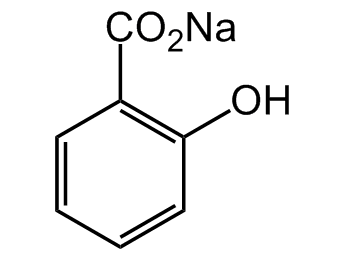Sodium salicylate
| Code | Size | Price |
|---|
| CDX-S0145-G025 | 25 g | £45.00 |
Quantity:
| CDX-S0145-G100 | 100 g | £80.00 |
Quantity:
Prices exclude any Taxes / VAT
Overview
Regulatory Status: RUO
Shipping:
Ambient
Storage:
Short term: +20°C, Long term: +20°C
Images
Documents
Further Information
Alternate Names/Synonyms:
2-Hydroxybenzoic acid sodium salt
Appearance:
White to off-white crystalline powder.
CAS:
54-21-7
EClass:
32160000
Form (Short):
solid
GHS Symbol:
GHS07, GHS08
Handling Advice:
Protect from light and moisture.
Hazards:
H302 - H319 - H361d
InChi:
InChI=1S/C7H6O3.Na/c8-6-4-2-1-3-5(6)7(9)10;/h1-4,8H,(H,9,10);/q;+1/p-1
InChiKey:
ABBQHOQBGMUPJH-UHFFFAOYSA-M
Long Description:
Chemical. CAS: 54-21-7. Formula: C7H5O3 . Na. MW: BD9837. Sodium salicylate is a metabolite of aspirin. It is a cell-permeable, non-steroidal anti-inflammatory agent (NSAID) that interferes with TNF-induced NF-kappaB activation by inhibiting phosphorylation and subsequent degradation of the IkappaB-alpha protein. It selectively inhibits TNF-induced activation of p42 (ERK2) and p44 (ERK1) MAP kinases and TNF-induced activation of JNK. It induces apoptosis via p38 kinase activation and inhibits COX-2 and inducible NOS (iNOS) transcription dependent on the experimental setup. It is commonly used for its antipyretic, anti-oxidant, neuroprotective, anti-inflammatory, anti-cancer and analgesic properties.
MDL:
MFCD00002440
Molecular Formula:
C7H5O3 . Na
Molecular Weight:
160.1
Package Type:
Vial
Precautions:
P202 - P264 - P270 - P301 + P312 - P305 + P351 + P338 - P308 + P313
Product Description:
Sodium salicylate is a metabolite of aspirin. It is a cell-permeable, non-steroidal anti-inflammatory agent (NSAID) that interferes with TNF-induced NF-kappaB activation by inhibiting phosphorylation and subsequent degradation of the IkappaB-alpha protein. It selectively inhibits TNF-induced activation of p42 (ERK2) and p44 (ERK1) MAP kinases and TNF-induced activation of JNK. It induces apoptosis via p38 kinase activation and inhibits COX-2 and inducible NOS (iNOS) transcription dependent on the experimental setup. It is commonly used for its antipyretic, anti-oxidant, neuroprotective, anti-inflammatory, anti-cancer and analgesic properties.
Purity:
>99% (dried substance)
Signal Word:
Warning
SMILES:
OC1=C(C(O[Na])=O)C=CC=C1
Solubility Chemicals:
Soluble in water (50mg/ml) or ethanol.
Source / Host:
Synthetic.
Transportation:
Non-hazardous
UNSPSC Number:
12352200
Use & Stability:
Stable for at least 2 years after receipt when stored at RT.
References
(1) R.S. Farivar & P. Brecher; J. Biol. Chem. 271, 31585 (1996) | (2) P. Schwenger, et al.; J. Biol. Chem. 271, 8089 (1996) | (3) J.A. Mitchell, et al.; Mol. Pharmacol. 51, 907 (1997) | (4) P. Schwenger, et al.; PNAS 94, 2869 (1997) | (5) P. Schwenger, et al.; Mol. Cell. Biol. 18, 78 (1998) | (6) R. Amann & B.A. Peskar; Eur. J. Pharmacol. 447, 1 (2002) | (7) P. Thakur & B. Nehru; Neuroscience 231, 420 (2013) | (8) C. Yu, et al.; Cancer med. 7, 471 (2018)



